Key takeaways
- Jigsaw puzzles enhance family bonding by encouraging teamwork, communication, and shared experiences, making quiet activities an opportunity for connection.
- Choosing age-appropriate puzzles with engaging themes fosters children’s confidence and excitement, leading to meaningful interactions.
- Establishing regular puzzle time creates cherished routines and enhances family ties through consistent shared activities.
- Overcoming challenges in puzzle-solving promotes patience, problem-solving, and teamwork, turning obstacles into opportunities for collaboration.
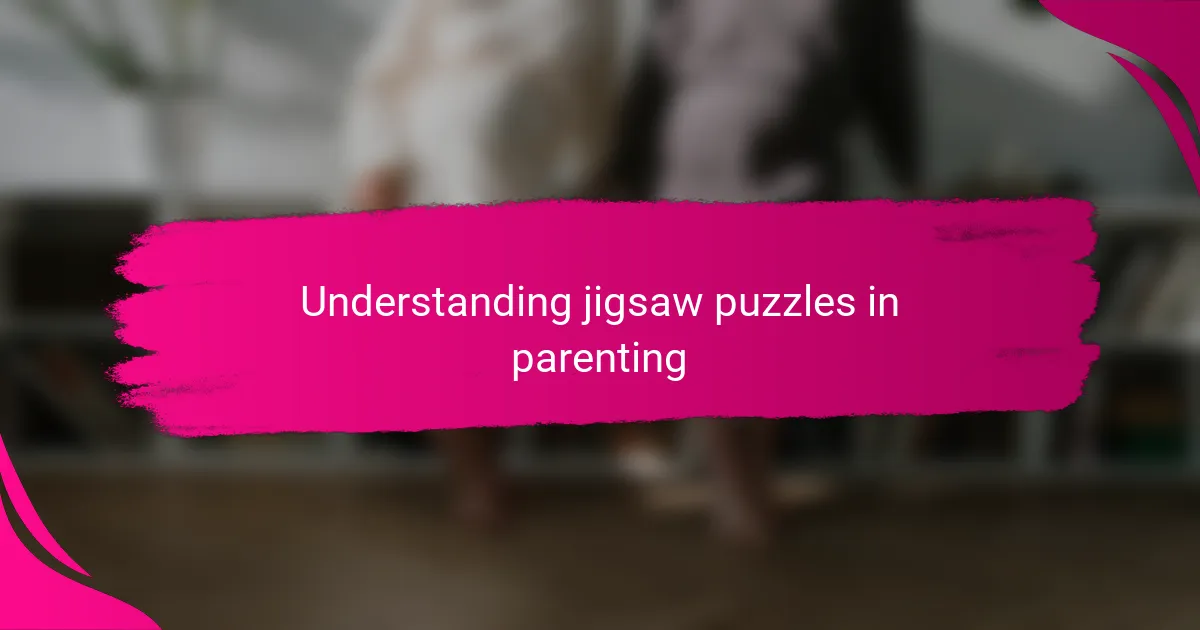
Understanding jigsaw puzzles in parenting
Jigsaw puzzles might seem like simple games, but in parenting, they offer so much more than just a pastime. I’ve found that sitting down with my kids over a puzzle creates a space for calm yet focused interaction. Isn’t it amazing how something as ordinary as fitting pieces together can bring out patience and collaboration in everyone?
When you think about it, puzzles naturally teach problem-solving and perseverance—skills we all want our children to develop. I remember the excitement on my child’s face when they finally placed that stubborn piece correctly; it felt like a small victory shared between us. Don’t those moments make you realize how powerful these quiet activities can be for family bonding?
Also, puzzles encourage communication without pressure. While working together to complete a picture, conversations flow naturally—about the image, guessing what comes next, or just sharing laughter over silly mistakes. From my experience, these gentle interactions build trust and deepen connections in ways traditional conversations sometimes can’t. Have you noticed that too?
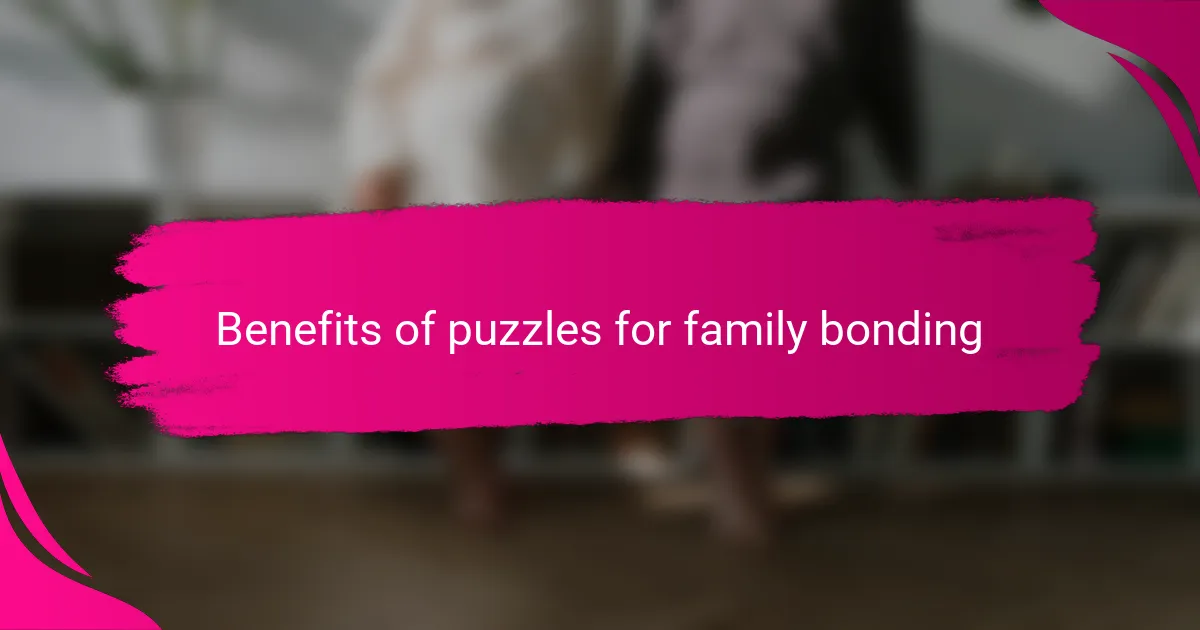
Benefits of puzzles for family bonding
There’s something truly special about the way puzzles bring our family together. When we gather around the table, each piece we connect feels like a tiny thread weaving our stories closer. I’ve seen how those shared moments spark teamwork and a sense of achievement that we all cherish.
What surprises me most is how puzzles gently shift our focus from distractions to the present moment. In those quiet pauses, we listen to each other more, laugh a little louder, and celebrate every small success as a team. Isn’t it wonderful how something so simple can deepen our bonds so naturally?
I also appreciate how puzzles give everyone a chance to contribute, no matter their age or skill level. Watching my youngest take pride in placing a tricky piece reminds me that family bonding thrives on encouragement and shared experiences. Don’t these little victories create memories that last far beyond the puzzle board?
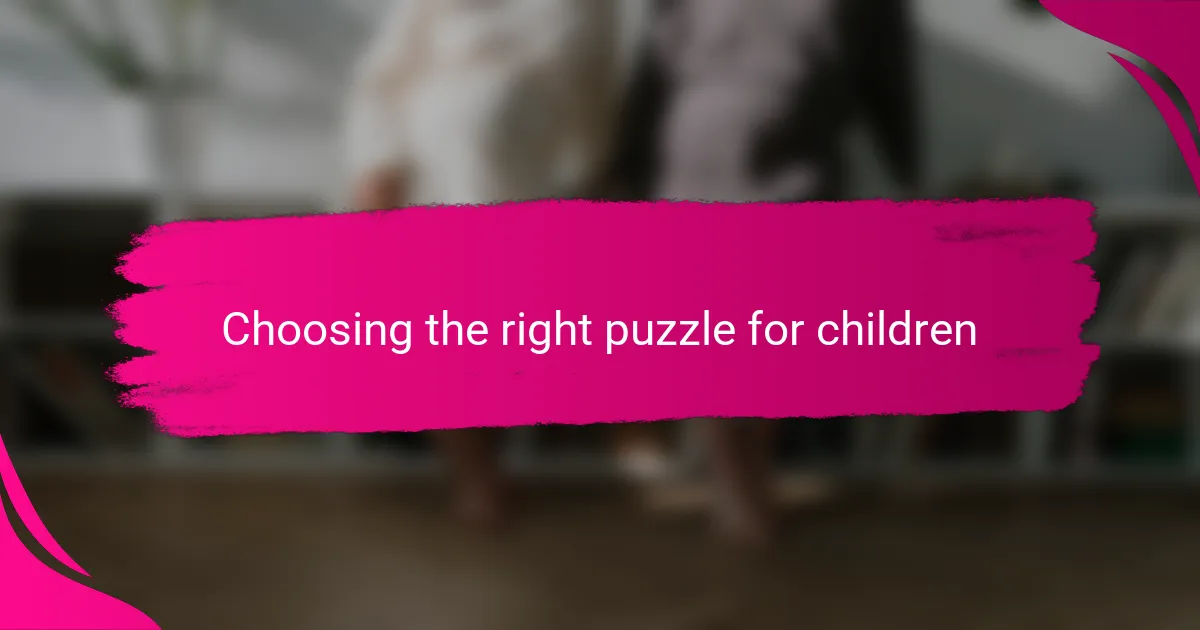
Choosing the right puzzle for children
Finding the right puzzle for children can make all the difference in creating those magical bonding moments. I’ve learned to pick puzzles with larger pieces and colorful, familiar images for my little ones—it keeps them engaged without overwhelming them. Have you noticed how a puzzle that feels ‘just right’ sparks confidence and excitement in kids?
Age matters a lot when choosing a puzzle. For toddlers, simple puzzles with fewer pieces work wonders, while older kids enjoy more complex challenges that stretch their thinking. I remember when my eight-year-old tackled a 200-piece puzzle for the first time; the pride in their eyes was priceless. Doesn’t it feel great to watch them grow through these small achievements?
Also, themes can be a game-changer. My family loves choosing puzzles with animals, nature, or favorite cartoons because they naturally spark conversation and curiosity. Have you tried picking puzzles that connect with your child’s interests? It’s amazing how those shared passions turn an ordinary activity into a memorable experience.

Creating puzzle time routines
Establishing a regular puzzle time really transformed our evenings. I noticed that setting aside a specific day each week made everyone anticipate those moments, turning puzzle-building into a cherished routine rather than a one-time activity. Have you ever experienced how consistent rituals can quietly strengthen family ties without even trying?
Sometimes, we’d light a small lamp and gather around the kitchen table, making it an inviting little world just for us. Creating that cozy atmosphere wasn’t about perfect timing but about being present together, and that feeling made all the difference. Isn’t it interesting how simple habits can become the glue holding family moments intact?
I also found that involving the kids in deciding the puzzle day gave them a sense of ownership and excitement. When my child chose Friday evenings as “puzzle night,” it became something they looked forward to as much as I did. Doesn’t giving children this kind of choice make bonding feel more natural and joyful?
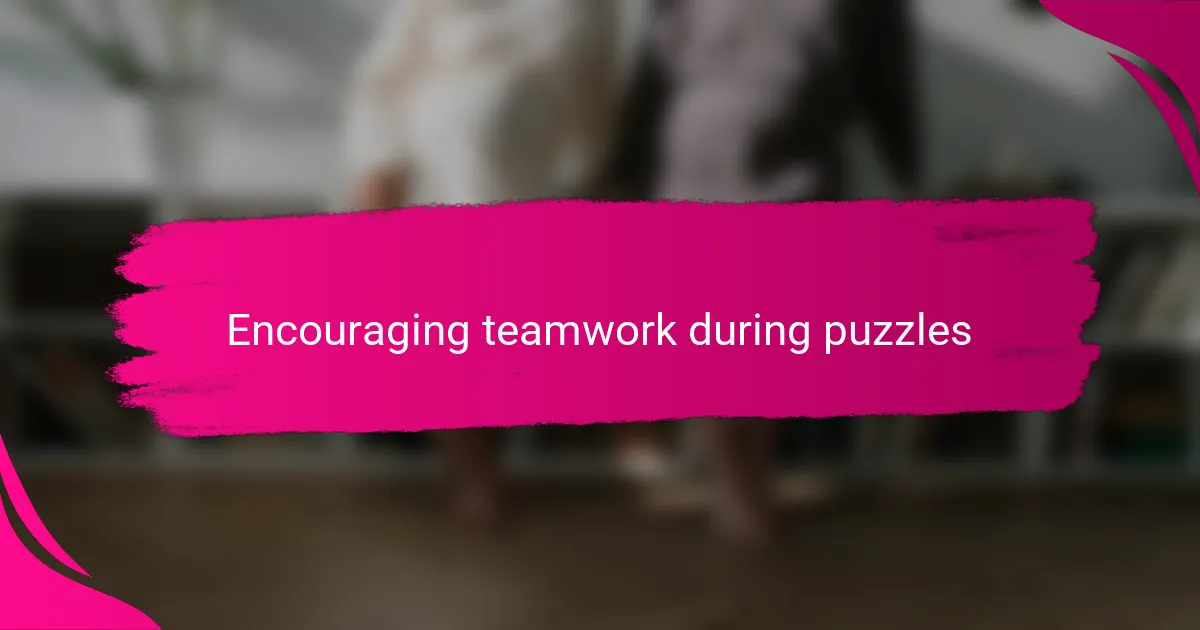
Encouraging teamwork during puzzles
One thing I’ve noticed is that encouraging teamwork during puzzles means gently guiding everyone to share their ideas and listen to each other. When my kids started suggesting where pieces might fit and then agreed or explored other options together, I saw their cooperation blossom. Isn’t it rewarding when a simple question like, “Where do you think this piece goes?” sparks a team effort rather than a solo mission?
I like to assign small roles as we work—sometimes one child sorts edge pieces while another looks for colors, and I join in fitting pieces together. This way, everyone feels important and knows their contribution matters. Have you tried dividing tasks during a puzzle? It’s amazing how it turns an individual challenge into a shared adventure.
Sometimes, I’ve watched frustration creep in, but instead of stepping in too quickly, I encourage my kids to ask for help or brainstorm together. That pause to problem-solve becomes a real lesson in patience and teamwork. Don’t those moments of collaboration, when everyone puts their heads together, create the best memories?
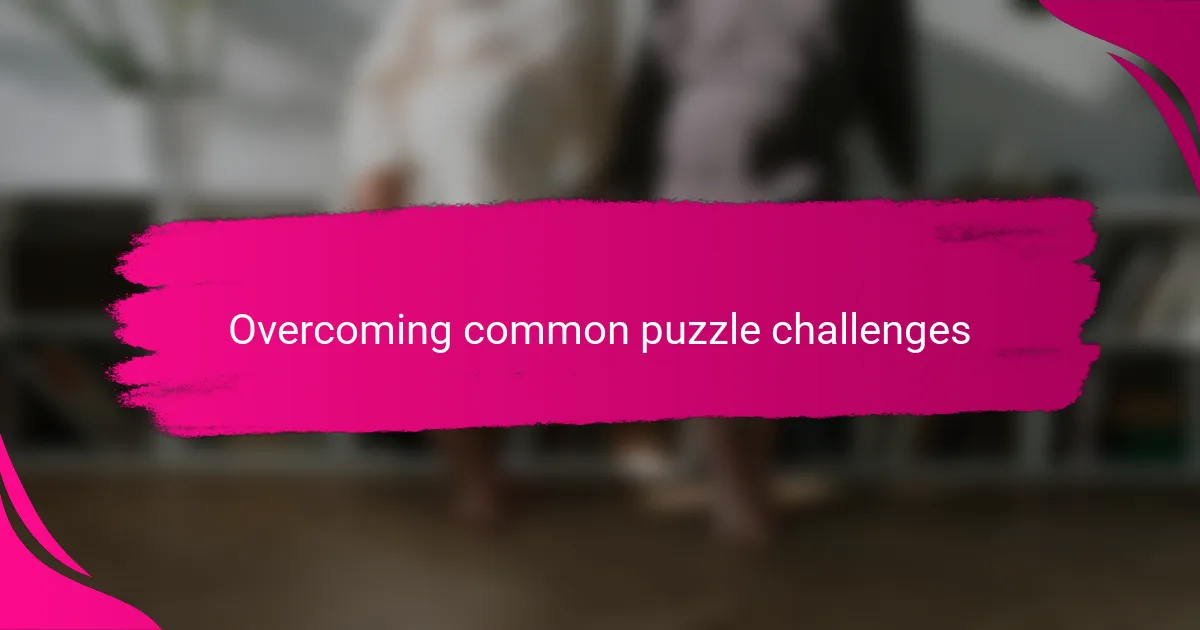
Overcoming common puzzle challenges
Challenges like missing pieces or confusing sections can derail the fun, but I’ve learned that patience is key. When my child felt stuck, we took a deep breath and revisited the puzzle with fresh eyes—often, that simple pause made all the difference. Have you noticed how stepping back sometimes reveals what you missed at first glance?
Sorting pieces by color or shape before diving in is another trick that saved us countless moments of frustration. I recall how organizing the pieces into groups not only made the process smoother but also gave the kids a sense of accomplishment right from the start. Doesn’t a little order make tackling chaos feel more manageable?
Frustration can bubble up, especially when pieces don’t seem to fit, but I find that turning the challenge into a game lightens the mood. Asking, “Where else could this piece go?” invites creativity instead of giving up, and it’s amazing to see how that mindset keeps everyone engaged and eager to try again. Have you found that a playful approach turns obstacles into opportunities?
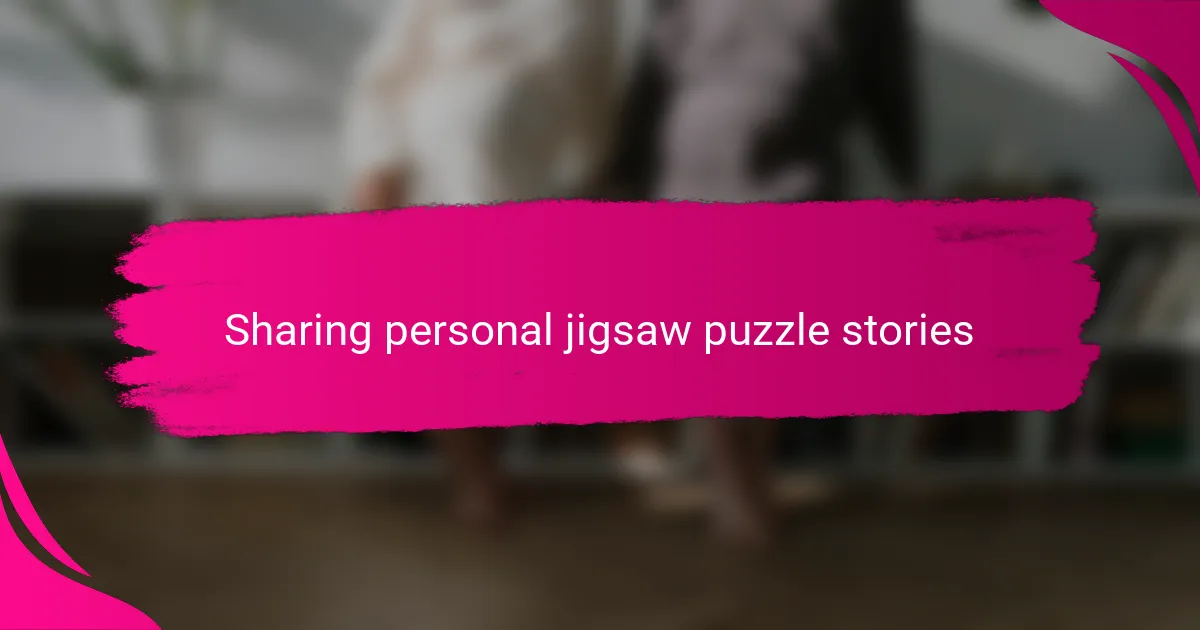
Sharing personal jigsaw puzzle stories
When I think back to our puzzle nights, one story always makes me smile. My youngest once proudly placed a piece completely by chance, and we all cheered like it was the grand finale. Moments like that, filled with unexpected joy and laughter, remind me how these simple puzzles become shared memories etched in our family’s story. Have you experienced those surprising little victories that just bring everyone closer?
Another time, while working on a particularly tricky puzzle, my teenager shared a story from school, and suddenly, the puzzle felt less like a task and more like a soundtrack to our conversation. I realized how puzzles often open doors to stories that might otherwise stay tucked away. Isn’t it fascinating how something as quiet as clicking pieces together can invite everyone’s voices?
Sometimes, I notice that the stories we share over puzzles aren’t just about the puzzle itself but about learning from each other. When my kids suggest new strategies or tell me why they think a piece should fit somewhere, I see not just problem-solving but their unique perspectives shining through. Doesn’t this blend of creativity and connection make those puzzle times truly special?
